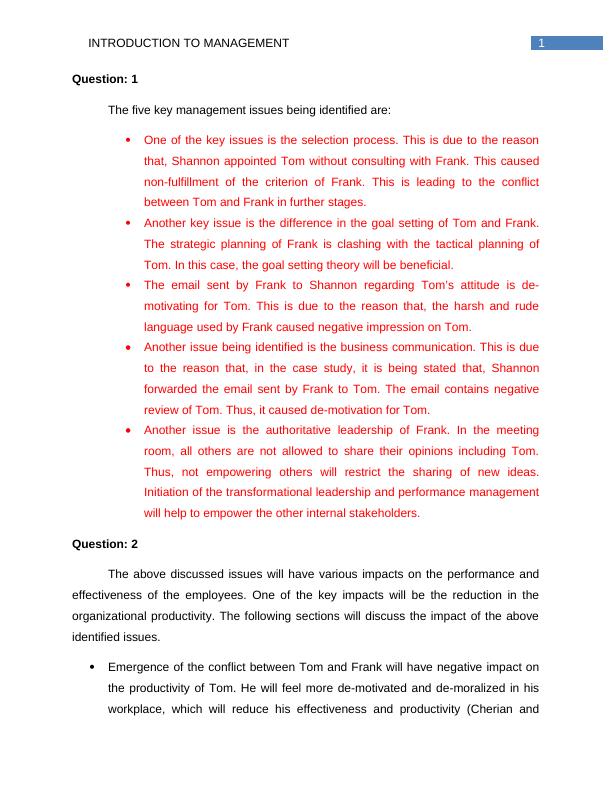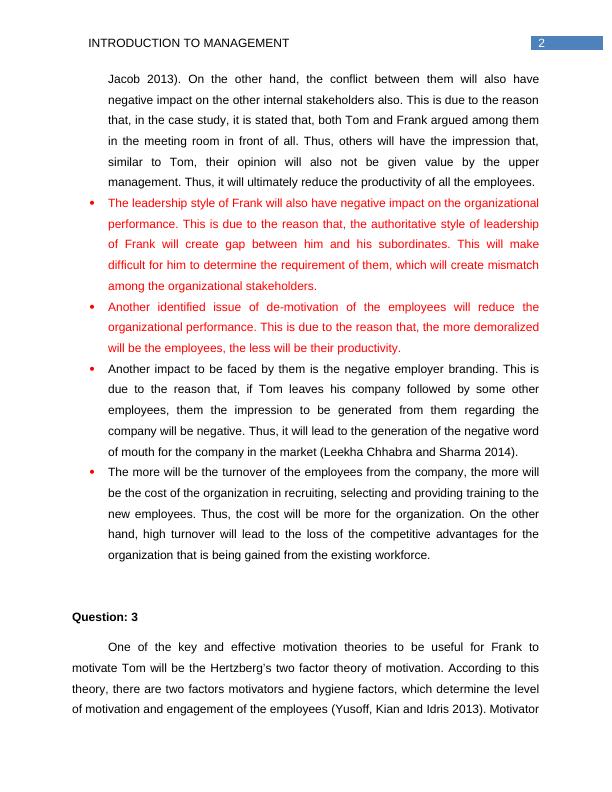Introduction to Management | Study
Added on 2020-05-16
9 Pages2843 Words47 Views
Running head: INTRODUCTION TO MANAGEMENTIntroduction to managementName of the studentName of the universityAuthor note

1INTRODUCTION TO MANAGEMENTQuestion: 1The five key management issues being identified are:One of the key issues is the selection process. This is due to the reasonthat, Shannon appointed Tom without consulting with Frank. This causednon-fulfillment of the criterion of Frank. This is leading to the conflictbetween Tom and Frank in further stages. Another key issue is the difference in the goal setting of Tom and Frank.The strategic planning of Frank is clashing with the tactical planning ofTom. In this case, the goal setting theory will be beneficial. The email sent by Frank to Shannon regarding Tom’s attitude is de-motivating for Tom. This is due to the reason that, the harsh and rudelanguage used by Frank caused negative impression on Tom.Another issue being identified is the business communication. This is dueto the reason that, in the case study, it is being stated that, Shannonforwarded the email sent by Frank to Tom. The email contains negativereview of Tom. Thus, it caused de-motivation for Tom.Another issue is the authoritative leadership of Frank. In the meetingroom, all others are not allowed to share their opinions including Tom.Thus, not empowering others will restrict the sharing of new ideas.Initiation of the transformational leadership and performance managementwill help to empower the other internal stakeholders. Question: 2The above discussed issues will have various impacts on the performance andeffectiveness of the employees. One of the key impacts will be the reduction in theorganizational productivity. The following sections will discuss the impact of the aboveidentified issues.Emergence of the conflict between Tom and Frank will have negative impact onthe productivity of Tom. He will feel more de-motivated and de-moralized in hisworkplace, which will reduce his effectiveness and productivity (Cherian and

2INTRODUCTION TO MANAGEMENTJacob 2013). On the other hand, the conflict between them will also havenegative impact on the other internal stakeholders also. This is due to the reasonthat, in the case study, it is stated that, both Tom and Frank argued among themin the meeting room in front of all. Thus, others will have the impression that,similar to Tom, their opinion will also not be given value by the uppermanagement. Thus, it will ultimately reduce the productivity of all the employees. The leadership style of Frank will also have negative impact on the organizationalperformance. This is due to the reason that, the authoritative style of leadershipof Frank will create gap between him and his subordinates. This will makedifficult for him to determine the requirement of them, which will create mismatchamong the organizational stakeholders. Another identified issue of de-motivation of the employees will reduce theorganizational performance. This is due to the reason that, the more demoralizedwill be the employees, the less will be their productivity. Another impact to be faced by them is the negative employer branding. This isdue to the reason that, if Tom leaves his company followed by some otheremployees, them the impression to be generated from them regarding thecompany will be negative. Thus, it will lead to the generation of the negative wordof mouth for the company in the market (Leekha Chhabra and Sharma 2014). The more will be the turnover of the employees from the company, the more willbe the cost of the organization in recruiting, selecting and providing training to thenew employees. Thus, the cost will be more for the organization. On the otherhand, high turnover will lead to the loss of the competitive advantages for theorganization that is being gained from the existing workforce. Question: 3One of the key and effective motivation theories to be useful for Frank tomotivate Tom will be the Hertzberg’s two factor theory of motivation. According to thistheory, there are two factors motivators and hygiene factors, which determine the levelof motivation and engagement of the employees (Yusoff, Kian and Idris 2013). Motivator

End of preview
Want to access all the pages? Upload your documents or become a member.
Related Documents
Introduction to Management: Issues, Impact, Motivational Theories, HR Theories, and Leadership Theorieslg...
|8
|2090
|420
Introduction to Management: Case Study Analysis and Application of Motivation and Leadership Theorieslg...
|10
|1979
|251
Journal of Organizational Behavior (Doc)lg...
|19
|4369
|31
Qualities of Leadership: Traits That Exemplify Effective Leadershiplg...
|5
|730
|157
Essay on Managing Employee Behaviorlg...
|9
|2156
|130
Organisational Behaviour Issues in Thames Valley Building Societylg...
|16
|1352
|144
